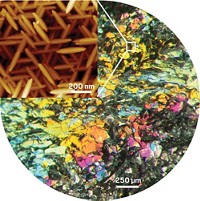Advertisement
Grab your lab coat. Let's get started
Welcome!
Welcome!
Create an account below to get 6 C&EN articles per month, receive newsletters and more - all free.
It seems this is your first time logging in online. Please enter the following information to continue.
As an ACS member you automatically get access to this site. All we need is few more details to create your reading experience.
Not you? Sign in with a different account.
Not you? Sign in with a different account.
ERROR 1
ERROR 1
ERROR 2
ERROR 2
ERROR 2
ERROR 2
ERROR 2
Password and Confirm password must match.
If you have an ACS member number, please enter it here so we can link this account to your membership. (optional)
ERROR 2
ACS values your privacy. By submitting your information, you are gaining access to C&EN and subscribing to our weekly newsletter. We use the information you provide to make your reading experience better, and we will never sell your data to third party members.
Materials
Revealing The Nano In Earthquakes
by Jyllian Kemsley
December 15, 2014
| A version of this story appeared in
Volume 92, Issue 50
Earthquakes jar at the macroscopic level: Ground ruptures; houses shake. But their effects can also be discerned at the nano level. Crushed wear material between rock faces that slip past each other develop patches of mirrorlike areas characterized by nanostructures. Investigating the effect in limestone, researchers led by Berend A. Verberne and Christopher J. Spiers of the Netherlands’ Utrecht University have now found that nanoparticles 5–20 nm in diameter cluster into spherules, which in turn align into nanofibers oriented along the slip direction (Science 2014, DOI: 10.1126/science.1259003). The nanofiber patches are small—10–100-µm wide—and can form with as little as 5-mm rock displacement under typical earthquake-related pressures. The changes in the rock are a product of the energy put into the system, Verberne says. And the movement of the nanoparticles and their alignment into the fibers could play an important role in how the rocks slip. Although Verberne and colleagues only studied limestone, the mirrorlike patches are found in other rock types, suggesting a general mechanism may be at work.





Join the conversation
Contact the reporter
Submit a Letter to the Editor for publication
Engage with us on Twitter